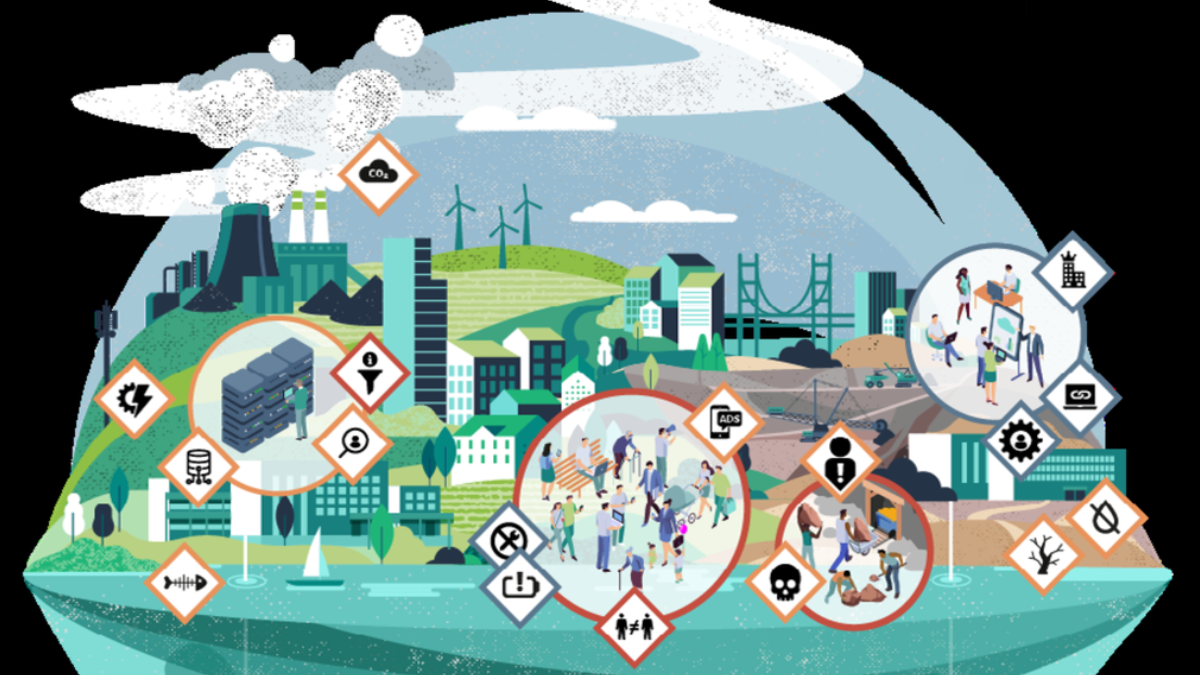Smarter Grids Emerge as a Solution for AI and Green Energy Needs
Trevor Gamble-Borsh / Aug 22, 2025
This illustration of urban life shows groups of people, buildings, bridges, power plants, mining areas, data centers and wind power stations. (Lone Thomasky & Bits&Bäume / Better Images of AI / CC by 4.0)
After years of decline in advanced economies, the global demand for energy has spiked.
Driven by the rising demand for cooling systems as global temperatures rise, the electrification of the automotive and mobility sectors, and an explosion of data centers and artificial intelligence infrastructure, the International Energy Agency (IEA) found that in 2024 global energy demand rose by 2.2%. Of that new electrical generation, 80% came from renewable and nuclear energy sources.
In spite of these economic trends, the US federal government under the Trump administration has made a primary enemy out of renewable energy, which research shows typically delivers power at a lower cost than fossil-fuel based alternatives. The White House has made its approach to renewables and climate especially loud and clear, taking sweeping actions to override scientific and legal precedents as foundational to climate protection as the 2009 “endangerment finding,” which underpins the federal government’s ability to regulate climate threats. This increased level of cost and economic inefficiency is only beginning to roll out, with now expected new highs in US energy use in the coming years set to further strain costs and infrastructure.
This is not to say that the federal government is curbing energy production; quite the opposite.
The White House’s “AI Action Plan” looks to prioritize energy production and infrastructure with massive expansion in the name of AI leadership. This prioritization is especially focused on furthering the proliferation of fossil fuels, emphasizing oil, natural gas, and coal as foremost in the lineup of “solutions” to growing US energy demand. This skyrocketing demand for energy in our present era of AI development is of course tied largely to the monumental appetites of data centers. As it stands, Reuters reports that the Department of Energy “forecasts 20 GW of new data center load by 2030 and predicts data centers will consume 6.7%-12% of total U.S. power production by 2028, up from 4.4% in 2023.” This ongoing boom already contributed to an average of 6% rise in electricity rates nationally last year, and has many communities fighting against data centers being built nearby in order to combat energy and water strains (one example being the tensions over the “Project Blue” Data Center in Arizona, where data centers could eat up 16% of total state energy by 2030).
Such expansion and output from our energy sector without renewables at the core creates near-term cost and long-term economic and social damage. Yet despite green energy’s proven and significant economic efficiencies, the Trump administration’s harmful approach is unlikely to shift.
Renewables, however, are not the only piece of our climate puzzle that require solving. Just as reducing carbon emissions is only one of many actions required to protect ourselves from environmental (and thus economic) catastrophe, the architecture and technologies within the grid itself remain an unsung and woefully unaddressed key to our energy transition.
As it stands, even if every home were provided with rooftop solar arrays and an electric vehicle (EV), outdated infrastructure would leave many (especially impoverished and BIPOC) communities unable to operate any of it. In general, the quality of our grids has also been declining, with outages more likely now than two decades ago. Additionally, while there will always be some cost in the movement of energy, electricity transmission and distribution in the U.S. averages about a 5% energy loss annually to simply transport to users from often far-off producers.
As this peak in demand leads to skyrocketing energy bills, states are taking notice with governors coast to coast awarding funds for improved grid efficiencies, announcing action plans to increase resilience, and even beginning to restructure state grid operations and infrastructure. California, the fourth-largest energy producer in the nation and third-largest energy importer, has been embroiled in a fight over whether or not to establish a regional electricity market that could tie together “the American West’s three dozen independent power grids.” On the one hand, a larger and interconnected market could allow for cheaper costs and some efficiencies even for renewable energy projects. On the other hand, concerns of centralized market manipulation as well as ceding grid independence to interstate and federal powers in a time of federal energy inefficiencies poses a monumental risk — especially as this administration has already shown willingness to impose itself on Californian state matters of environmental and domestic security concern.
Though AI’s seemingly insatiable hunger for electricity only exacerbates these issues, the tech industry and relatively simple applications of AI with internet of things (IoT) tools can play a key role in curbing this disruption as well as social and ecological damage.
While not an immediate solution, Oregon has made an especially tactful, nationally-leading move toward long-term increased grid quality and intelligence: creating a new legislative framework with a focus on expediting and increasing microgrid access across urban, suburban, and rural communities. After the recent signage of Oregon House Bills 2065 and 2066, Governor Tina Kotek’s Office celebrated the microgrid-focused bills passing, stating that these “new laws will make it possible for communities to plan, build, own, and value local microgrids and connect them to the larger grid.”
Microgrids are potentially autonomous systems that function at local levels to manage energy needs. That local level could be a single house or a small community, but importantly an interoperable and intelligent microgrid functions to manage energy needs across its local inputs and outputs with maximum efficiency and true independence in the event of a wider grid failure (from say an extreme weather event or grid security threat). A primary example of microgrid functionality is an individual who uses rooftop solar panels to generate their energy needs, drives an EV, and has a home battery. Their solar panels generate energy which is then dispersed to where it is needed for use in their home, as well as stored when generated in excess in the home and vehicle batteries. This user is generating, using, and storing all of the energy they need, and potentially even reselling excess energy generated back into the larger grid network, supporting their neighbors’ energy needs while bringing down everyone’s energy bills thanks to increased energy generation capacity and a simplified transmission process.
The interoperable power of microgrid technologies is already a sought after solution in the tech space, with an increasing number of players developing on-phone, smart home energy use regulation apps, third-party bidirectional charging modifications, universal adapters for multidirectional energy flows, and of course Tesla’s Powerwall lineup which paid out nearly $10-million to users in 2024 via decentralized grid technology. The combination of these in-home, intelligent technologies has continued to prove valuable in various real-world settings – including in California’s recent win of utilizing 100,000 home battery systems to support a “Virtual Power Plant” (VPP) that delivered 535 megawatts back into the grid during a pilot run.
The value of such personal and local energy independence has especially been growing in the face of rising heat and extreme weather events. Given that this growing strain is occurring alongside the increased energy demand of data centers, sentiments of innovation here should also extend beyond grid improvement and into our wider booming tech landscape. A fully optimizing microgrid also requires a certain level of AI reasoning to manage its energy needs live, as well as maximize efficiency and cost savings, making the move toward distributed energy a case for both survival and growth in computational capabilities.
Though the potential for independent and autonomous energy islanding carries sweeping operational implications for maintenance and ownership, the likelihood is that community-level, coordinated energy operations via microgrids are the most efficient systems to run. This approach creates a geographically and populously smaller iteration of the California grid regionalization dynamic, but at a smaller scope in which users still benefit from collective energy pooling while having greater agency over personally owned and locally associated operations. In scenarios where these microgrids are run on renewable generation, there are of course implications of cleaner and healthier environmental factors such as air and water quality while also reducing transmission infrastructure costs over wider swaths of territory and increasing infrastructural intelligence thanks to now-smarter energy capture, storage, and transmission technologies.
I have a bias for microgrid technologies, having previously worked helping to develop intelligent, localized grid management systems for V2G interoperability with EVs. Despite some very real privacy concerns around hyper-localized, intelligent grid systems, it is my (and seemingly a growing number of policymakers’) belief that microgrids are a core component of a fully-realized, cheaper, reliable, intelligent, and renewable grid.
What Oregon has done is pass “the most ambitious microgrid legislation in the nation,” with bipartisan support, to better enable communities to build microgrids. While this framework is a leader, Oregon isn't entirely alone: Texas has also set its sights on distributed energy via microgrid investment, and the Department of Energy (DOE) recently announced $8M in funding for microgrid innovation. The DOE even has a limited but existent history celebrating microgrid successes as well, including proof-of-concept via partnership with Siemens to build microgrid energy management systems that protected against physical threats and cyberattacks.
It’s no coincidence that this microgrid legislation and investment comes at a time when energy storage and management systems are taking off at a consumer level, with competition beginning to ramp up in the home energy autonomy tech market. Even in the face of renewable energy headwinds, the cost savings of an intelligent grid are a not-as-politicized, much needed solution gaining consumer and industrial traction. As the federal government impedes our energy progress and economic efficiency, state and local policymakers should once again take the lead on climate-economic action to promote these enhancements from a standpoint of savings, security, and development in a time where the US energy industry continues to fall staggeringly behind in the global electricity, energy storage, and transmission revolution. To do otherwise would impede AI and climate goals alike, while continuing to support pushes toward foreign energy dominance and underserve ourselves domestically.
Authors
